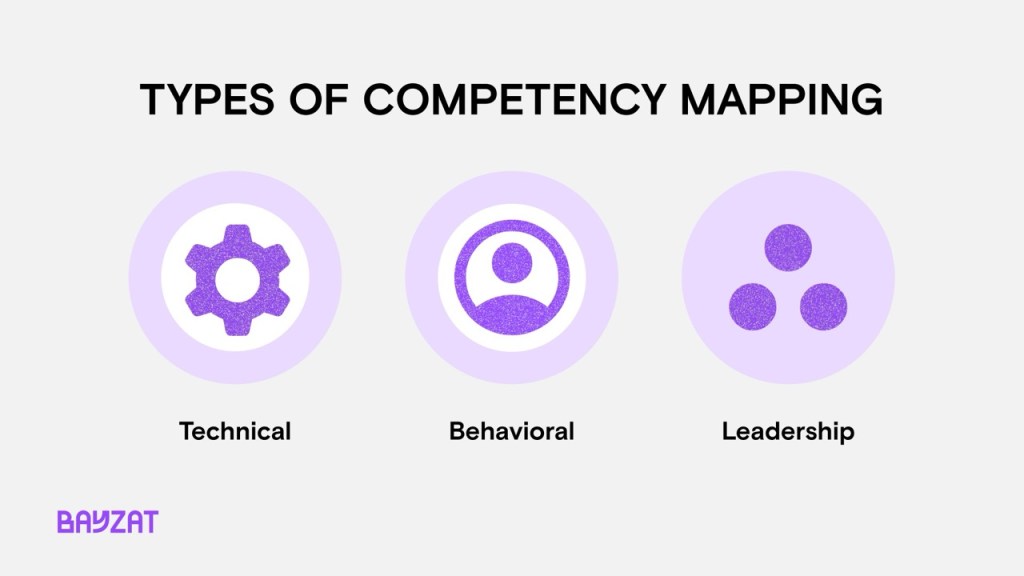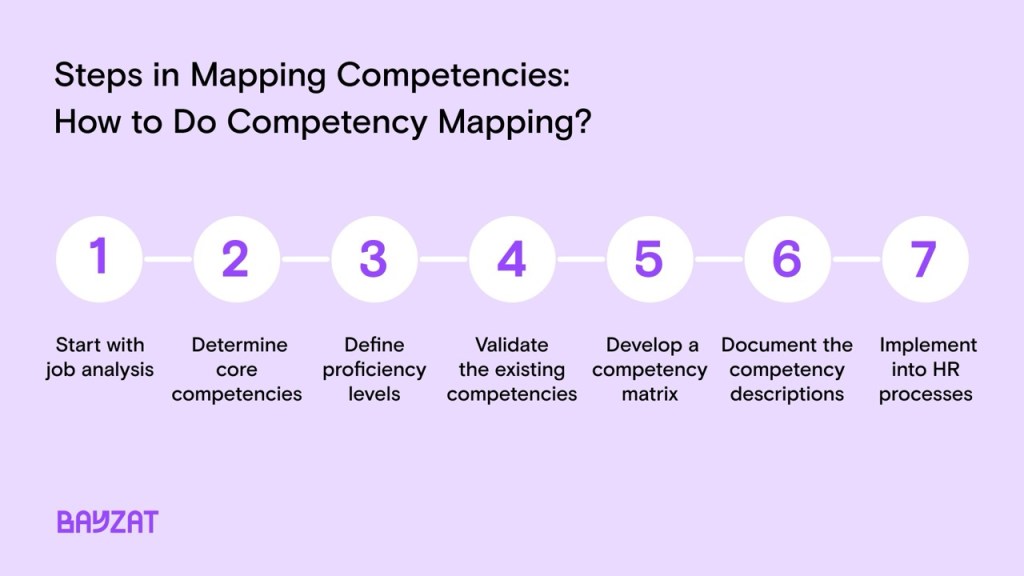When hiring new employees, every role within an organization calls for a unique blend of different competencies. These could be anything from hard skills to soft skills, and behavariol attributes that are necessary for the employee to successfully perform their job.
And to make smarter hiring decisions, it’s important to have a clear understanding of what it takes to excel in a particular role. That’s why many HR managers are now turning to competency mapping to help identify skill sets and gaps in individuals or teams. Competency mapping also helps in reducing the risk of hiring the wrong person.
In this article, we define competency mapping, discuss various types of competency mapping, and the strategic value it can bring to UAE HR managers.
What Is Competency Mapping?
Competency mapping is a strategic HR process of identifying and analyzing the knowledge, sets, abilities, and behavior attributes that are required to perform a specific job or role effectively. Think of it as a strategic talent management tool that can help HR managers and businesses evaluate candidates in a more structured, methodical way that is easy to implement and measure.
The goal is to fully understand each individual’s competencies and skills that are required for a job as well as any noticeable gaps within these characteristics and then compare them to the competencies that are necessary for success within a specific role. For instance, if a position requires strong communication skills and problem-solving abilities, competency mapping will help filter out candidates who may lack these essential competencies.
There are various ways to map competencies, including through interviews, assessments, job descriptions, and performance appraisals. Each method is tailored to gather specific information on an individual’s competencies and skills.
It’s important to note that it can be difficult to gauge or measure some competencies and skills or improve them through learning and development. However, the odds of your employees reaching the highest potential are greater if more growth opportunities are provided.
Besides being used in talent management, HR managers and professionals also use competency mapping in performance management. The competencies mapped to a particular job are mapped against the competencies of the employee undertaking that role.
That is, employees are given a set of competencies they will be assessed against to know what is expected of them, where they need to improve within each competency, and how they’re performing in comparison to the role’s requirements.
The Difference Between Skill Matrix and Competency Mapping
A common misconception is that competency mapping and skill matrix are the same things. While both tools are used to assess an individual’s or group’s potential, they differ in their approach and strategic value.
A skill matrix is a method used to solely identify the person’s skills that are red for a particular job or role. It’s usually presented as a grid with employees on one axis and skills on the other. The purpose of the tool is to help HR managers and professionals determine which employees possess certain skills and where there may be gaps within a team. The tool is also useful in assessing how equipped a team is to perform a specific task.
On the flip side, competency mapping takes a more holistic approach by not only focusing on skills but also on knowledge, abilities, behavior, and attitude. It provides more insight into an individual’s potential at a deeper level. It helps organizations see how an individual’s competencies can benefit the organization and also where improvement is needed.
Types of Competency Mapping
Typically, competencies can be mapped from various perspectives, creating frameworks with a variety of competencies. However, in a professional setting, competencies can be broadly classified into three main categories:

1. Technical
Mapping technical or domain-specific competencies allows HR managers to focus on the specific skills and knowledge required for hands-on roles. These competencies are usually specific to a particular job or industry and reflect the required education, training, and experience for that role. For example, understanding programming languages is a technical competency for software developers, and knowledge of CRM tools is a technical competency for sales teams.
2. Behavioral
Along with technical know-how, employees also need certain soft skills and behavioral attributes to excel in their roles. Behavioral competencies include a person’s soft skills and emotional intelligence. These include communication, teamwork, problem-solving, adaptability, creativity, and other interpersonal skills that are essential in any role. Behavioral competencies can be more difficult to assess but are crucial in determining an employee’s potential for growth and development.
3. Leadership
Every organization needs strong leaders to drive success and growth. Mapping leadership competencies allows HR managers to identify potential leaders within the organization or when hiring new talent. Attributes such as embracing diversity, nurturing innovation, and inspiring others are all leadership competencies that can be mapped and evaluated for employees.
How to Interpret Competency Levels
To fully understand an individual’s competencies, a four-level competency scale is used. This helps HR managers and professionals differentiate between employees’ levels of proficiency in each competency. The most common scale ranges from basic to expert, with several different levels in between. The scale is subjective and can vary depending on the organization or industry. Here is an example of a four-level competency scale:
Level 1: Basic/Foundational
This level indicates that the individual has limited knowledge, skills, and experience. They are likely to perform and carry out simple tasks but still require guidance and support from others.
For example, an HR professional at this level may:
- Have a basic understanding of strategic HR principles and practices
- Struggle to handle complex HR tasks and projects independently or utilize data
- Need guidance in setting KPIs, and have limited knowledge of the company’s primary processes and goals
- Have limited digital capabilities and need support in using HR technology platforms.
Level 2: Intermediate/Developing
This level indicates that an employee has gained more knowledge, skills, and experience. They can perform most tasks independently without supervision but may still require guidance with more complex assignments. They are also seen as credible by their colleagues, focus on their new role, and occasionally promote diversity and foster inclusion,
The focus at this level is on developing on-the-job experience and enhancing skills to be able to take on more significant responsibilities. An HR professional at this level is developing expertise in:
- Strategic HR principles and practices in their role
- Utilize data and analytics
- Use HR technology platforms effectively
- Compliance and regulations
- Giving small presentations and setting KPIs
- Contributing to discussions and decision-making processes.
Level 3: Advanced/Proficient
At this level, the individual has gained significant knowledge, skills, and experience that enables them to perform complex tasks independently without supervision. They also possess strong analytical and cross-functional skills and are capable of training and mentoring other team members. They are regarded as credible by supervisors and managers since they require little to no guidance and are consistently looking for ways to progress in their roles.
An HR professional at this level may:
- Demonstrate expertise in advanced strategic HR principles and practices
- Use data analysis to create actionable insights
- Utilize various HR technology platforms with minimal support
- Set metrics, KPIs, and improve processes
- Articulate well in presentations and contribute to training less experienced team members
- Work collaboratively with other departments in the organization.
Level 4: Expert/Mastery
This is the highest level of competency and indicates that the individual has extensive knowledge, skills, and experience, making them a subject matter expert in their field. They are regarded as an authority in their field and can take on complex projects, lead teams, and develop strategies for the organization. They contribute significantly to the growth and success of the company.
An HR professional at this level may:
- Demonstrate mastery in data analysis
- Has strong analytical skills and ability to use data for decision-making
- Is capable of setting KPIs, analyzing reports, and understanding HR trends in line with strategic business objectives
- Demonstrates to stakeholders how HR contributes to business objectives
- Works closely with executive leadership and other departments to drive organizational growth and success.
Ready to Unlock the Full Potential of Your Workforce?
Discover how Bayzat can transform your approach to competency mapping. Dive deeper into strategic talent management and gain the competitive edge you need.
Get BayzatStrategic Value of Competency Mapping to UAE HR Managers
Competency mapping is not just a talent or performance management tool. It also helps HR managers assess and close skills gaps and reduce turnover. In fact, research found that understanding skill gaps is a number one priority for talent developers worldwide.
In other words, competency mapping is a surefire approach to identifying these skill gaps, besides other “multi-pronged” approaches such as internal assessments, monitoring business KPIs, and conducting meetings with senior managers and managers.
Other strategic benefits of competency mapping for HR managers in the UAE include:
1. Building high-performing teams
Competency mapping allows HR managers to identify and develop high-performing teams by understanding the strengths and weaknesses of individual team members. This enables them to create a more balanced, skilled, and cohesive workforce that can drive success for the organization.
2. Making informed hiring and recruitment decisions
Statistics indicate that 80% of employee turnover is attributed to poor hiring decisions. By mapping competencies, HR managers can make more informed decisions when it comes to talent acquisition. It helps them craft a strong job description, identify what interview questions to ask, and what skills to test for during the recruitment process.
Competency mapping also allows HR managers to shape company culture in the hiring process by highlighting values and behaviors that require more representation within your workforce.
3. Boosting succession planning
Just as competency planning is essential for understanding skill gaps, it’s also crucial for succession planning. By mapping competencies, HR managers can identify high-potential employees and create development programs to prepare them for future roles.
This approach also ensures the organization has a pipeline for all levels, from entry-level to C-suite to fill critical roles in case of promotions, retirements, or resignations.
4. Increasing the person-job fit
Mapping competencies enables UAE HR managers to ensure that employees are well-suited for their roles, maximizing productivity and engagement. By understanding the required skills for each job, they can assess whether an employee’s skills match the position or if they would be better suited for a different role within the organization. This ensures a better person-job fit, leading to higher job satisfaction and retention rates.
5. Transparent career paths
HR managers who skillfully map out skills find it significantly easier to offer growth prospects to candidates and new hires. What’s more, such a career path is incredibly transparent to the worker. The result? Satisfied employees who understand exactly what they need to do to rise up the ranks.
Steps in Mapping Competencies: How to Do Competency Mapping?

1. Start with job analysis
A job analysis involves creating a list of roles for which the organization is seeking to map out competencies. Ideally, this process involves gathering information by having employees fill out a Position Information Questionnaire (PIQ) or conducting one-on-one interviews using this form.
Having a competency map for every role will help HR managers assess employees’ skills and how they fit into their roles. Evaluating and reviewing employees’ work history also helps provide an unbiased perspective of performance.
2. Determine core competencies
The next step involves analyzing the data you’ve collected from job analysis to determine the core competencies required for each role. These are the skills, knowledge, behaviors, motives, and ambitions. The goal of this step is to help an HR manager match each of these competencies to the daily responsibilities of each role
3. Define proficiency levels
As we’ve seen, there are various scales you can use to assess employees’ proficiency levels within each competency. That is, what skills do they possess, and to what extent?
During this phase, HR managers should also define what an “expert” level looks like for each competency. This helps determine the standard level of proficiency required for each role. For instance, entry-level roles may require more basic competencies than managerial positions.
4. Validate the existing competencies
Validation involves confirming that the identified competencies are essential for each role. This step often includes having a team of experts review the list of core competencies you’ve mapped out to ensure their accuracy and relevance.
5. Develop a competency matrix
A competency matrix is an effective way to map out each employee’s performance against core competencies, thereby identifying skill gaps. It also helps HR managers come up with a tangible framework for performance management and develop a template for what an ideal professional and organization should look like.
6. Document the competency descriptions
Compiling competency descriptions for each role is a crucial step in the mapping process. These should be detailed, explaining what each competency entails and why it’s important for the role. This helps individuals understand what is expected of them in terms of job performance and development. Once documented, these competency descriptions can also be used as a reference for employee evaluations and career development plans.
7. Implement into HR processes
The final step in competency mapping is to integrate it into HR processes. Competency mapping should be used as a foundation for various processes such as recruitment, performance evaluation, assigning metrics to measure each competency, or developing additional training resources for specific departments or employees so they can improve in their areas of weakness.
Key Takeaway
Competency mapping is more than just a human resources tool, it’s an essential strategy for organizations to build and maintain a skilled and successful workforce. By understanding the competencies needed for each role, HR managers can make informed hiring decisions, boost succession planning efforts, improve person-job fit, enable transparent career paths, and integrate competency mapping into various HR processes. All these contribute to creating a strong and competent workforce, ultimately leading to organizational success. It can also help foster a culture of continuous learning and development, as employees are aware of the skills they need to improve and have access to the resources to do so.





Get Social